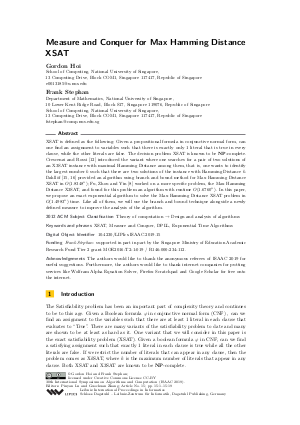Measure and Conquer for Max Hamming Distance XSAT
Authors Gordon Hoi, Frank Stephan
-
Part of:
Volume:
30th International Symposium on Algorithms and Computation (ISAAC 2019)
Part of: Series: Leibniz International Proceedings in Informatics (LIPIcs)
Part of: Conference: International Symposium on Algorithms and Computation (ISAAC) - License:
 Creative Commons Attribution 3.0 Unported license
Creative Commons Attribution 3.0 Unported license
- Publication Date: 2019-11-28
File

PDF
LIPIcs.ISAAC.2019.15.pdf
- Filesize: 471 kB
- 19 pages
Document Identifiers
Subject Classification
ACM Subject Classification
- Theory of computation → Design and analysis of algorithms
Keywords
- XSAT
- Measure and Conquer
- DPLL
- Exponential Time Algorithms
Metrics
- Access Statistics
-
Total Accesses (updated on a weekly basis)
0PDF Downloads0Metadata Views
Abstract
XSAT is defined as the following: Given a propositional formula in conjunctive normal form, can one find an assignment to variables such that there is exactly only 1 literal that is true in every clause, while the other literals are false. The decision problem XSAT is known to be NP-complete. Crescenzi and Rossi [Pierluigi Crescenzi and Gianluca Rossi, 2002] introduced the variant where one searches for a pair of two solutions of an X3SAT instance with maximal Hamming Distance among them, that is, one wants to identify the largest number k such that there are two solutions of the instance with Hamming Distance k. Dahllöf [Vilhelm Dahllöf, 2005; Vilhelm Dahllöf, 2006] provided an algorithm using branch and bound method for Max Hamming Distance XSAT in O(1.8348^n); Fu, Zhou and Yin [Linlu Fu and Minghao Yin, 2012] worked on a more specific problem, the Max Hamming Distance X3SAT, and found for this problem an algorithm with runtime O(1.6760^n). In this paper, we propose an exact exponential algorithm to solve the Max Hamming Distance XSAT problem in O(1.4983^n) time. Like all of them, we will use the branch and bound technique alongside a newly defined measure to improve the analysis of the algorithm.
Cite As Get BibTex
Gordon Hoi and Frank Stephan. Measure and Conquer for Max Hamming Distance XSAT. In 30th International Symposium on Algorithms and Computation (ISAAC 2019). Leibniz International Proceedings in Informatics (LIPIcs), Volume 149, pp. 15:1-15:19, Schloss Dagstuhl – Leibniz-Zentrum für Informatik (2019)
https://doi.org/10.4230/LIPIcs.ISAAC.2019.15
BibTex
@InProceedings{hoi_et_al:LIPIcs.ISAAC.2019.15,
author = {Hoi, Gordon and Stephan, Frank},
title = {{Measure and Conquer for Max Hamming Distance XSAT}},
booktitle = {30th International Symposium on Algorithms and Computation (ISAAC 2019)},
pages = {15:1--15:19},
series = {Leibniz International Proceedings in Informatics (LIPIcs)},
ISBN = {978-3-95977-130-6},
ISSN = {1868-8969},
year = {2019},
volume = {149},
editor = {Lu, Pinyan and Zhang, Guochuan},
publisher = {Schloss Dagstuhl -- Leibniz-Zentrum f{\"u}r Informatik},
address = {Dagstuhl, Germany},
URL = {https://drops.dagstuhl.de/entities/document/10.4230/LIPIcs.ISAAC.2019.15},
URN = {urn:nbn:de:0030-drops-115119},
doi = {10.4230/LIPIcs.ISAAC.2019.15},
annote = {Keywords: XSAT, Measure and Conquer, DPLL, Exponential Time Algorithms}
}
Author Details
- School of Computing, National University of Singapore, 13 Computing Drive, Block COM1, Singapore 117417, Republic of Singapore
Funding
- Stephan, Frank: supported in part in part by the Singapore Ministry of Education Academic Research Fund Tier 2 grant MOE2016-T2-1-019 / R146-000-234-112.
Acknowledgements
The authors would like to thank the anonymous referees of ISAAC 2019 for useful suggestions. Furthermore, the authors would like to thank internet companies for putting services like Wolfram Alpha Equation Solver, Firefox Scratchpad and Google Scholar for free onto the internet.
References
-
Andreas Blass and Yuri Gurevich. On the unique satisfiability problem. Information and Control, 55(1-3):80-88, 1982.

-
David Eppstein. Small maximal independent sets and faster exact graph coloring. Proceedings of the Seventh Workshop on Algorithms and Data Structures, Springer Lecture Notes in Computer Science, 2125:462-470, 2001.

-
David Eppstein. Quasiconvex analysis of multivariate recurrence equations for backtracking algorithms. ACM Transactions on Algorithms, 2(4):492-509, 2006.

-
Fedor V. Fomin and Dieter Kratsch. Exact Exponential Algorithms. Texts in Theoretical Computer Science, EATCS, Springer, Berlin, Heidelberg, 2010.

-
Fedor V. Fomin, Fabrizio Grandoni and Dieter Kratsch. A measure and conquer approach for the analysis of exact algorithms. Journal of the ACM, 56(5):25, 2009.

-
Gordon Hoi, Sanjay Jain and Frank Stephan. A fast exponential time algorithm for Max Hamming X3SAT. Foundations of Software Technology and Theoretical Computer Science, FSTTCS, 2019.

-
Jesper Makholm Byskov, Bolette Amitzbøll Madsen and Bolette Skjernaa. New algorithms for exact satisfiability. Theoretical Computer Science, 332(1-3):515-541, 2005.

-
Linlu Fu, Junping Zhou and Minghao Yin. Worst case upper bound for the maximum Hamming distance X3SAT problem. Journal of Frontiers of Computer Science and Technology, 6(7):664-671, 2012.

-
Martin Davis and Hilary Putnam. A computing procedure for quantification theory. Journal of the ACM, 7(3):201-215, 1960.

-
Martin Davis, George Logemann and Donald W. Loveland. A machine program for theorem proving. Communications of the ACM, 5(7):394-397, 1962.

-
Oliver Kullmann. New methods for 3-SAT decision and worst-case analysis. Theoretical Computer Science, 223(1-2):1-72, 1999.

-
Pierluigi Crescenzi and Gianluca Rossi. On the Hamming distance of constraint satisfaction problems. Theoretical Computer Science, 288(1):85-100, 2002.

-
Rodney G. Downey and Michael R. Fellows. Fundamentals of Parameterized Complexity. Springer, Berlin, Heidelberg, 2013.

-
Stefan Porschen. On variable-weighted exact satisfiability problems. Annals of Mathematics and Artificial Intelligence, 51(1):27-54, 2007.

-
Vilhelm Dahllöf. Algorithms for Max Hamming Exact Satisfiability. International Symposium on Algorithms and Computation, ISAAC 2005, Springer Lecture Notes in Computer Science, 3827:829-383, 2005.

-
Vilhelm Dahllöf. Exact Algorithms for Exact Satisfiability Problems. PhD thesis, Department of Computer and Information Science, Linköping University, 2006.

-
Vilhelm Dahllöf, Peter Jonsson and Richard Beigel. Algorithms for four variants of the exact satisfiability problem. Theoretical Computer Science, 320(2-3):373-394, 2004.

